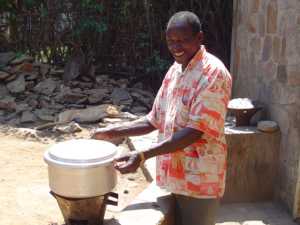[First posted November 2009, Revised 23 November 2011]
This is the last post I put up in 2009, before entering the hospital for ophthalmic shingles, and repost it as a very nice alternative to Thanksgiving ‘American style’ (no turkeys here!).
++++++++
In spite of all the difficulties of war, non-functioning infrastructure, lack of fuel, etc, here in Burundi – we are blessed with year-round crop and livestock systems – 3 cropping seasons and year-round kidding (birthing of goats)! As well, and in spite of what one might think from international news sources, Burundians are friendly, cooperative, hard-working and highly sociable. And they, too, love good food!
Last week I came out the front door of the house where I stay from time-to-time in the capital of Bujumbura, and saw that, by the door, the pomegranate ‘tree’ was in full fruit – that the avocado tree to the side of the house had numerous fruits on the ground – as did the quince tree next to it. And I knew that back out at the compound our papaya and lime trees were in full fruit [not yet the orange and grapefruit, however].
How to use all of these ripe fruits?
There are several really good dishes from the Middle East and Iran that use pomegranate juice as part of the marinade process and so searching back in my files I came up with the following – which is actually from Georgia, but Georgian cooking is very heavily influenced by Middle East cuisine, due to centuries of rule by the Ottoman Empire (and perhaps, Ottoman cuisine is equally influenced by that of Georgia?!).
With this, I made a salsa with the avocado and then a fruit cocktail for desert that also included bananas and marakuja from the nearby village.
Omer, our cook-paraveterinarian, brought some banana leaves from the village and made a local bread that is cooked by wrapping the dough in the banana leaf, placing it in a pot that is itself put in a large casserole with some water in the bottom and a couple of flat stones on which the small pot rests. Omer places this on a very hot charcoal burner that he likes to use in cooking [outside]:
 He’s also used this method to cook leftover pizza dough that he’s made, and its quite good.
He’s also used this method to cook leftover pizza dough that he’s made, and its quite good.
In the following recipe, I used meat from goat legs that I purchased at our Greek butcher in the capital, because we’ve no goats ready to slaughter just yet.

The Bucherie Nouveau, Bujumbura
Basturma (Georgian Pomegranate Marinated Grilled Lamb)
- 1 3/4 lbs Boneless leg of lamb or goat
FOR THE MARINADE:
- 2c fresh pomegranate juice )or 1 c pomegranate syrup)
- a sm onion, grated
- 2 cloves garlic, minced
- 1-4c extra virgin olive oil
- freshly ground black pepper
- 1-4c chopped fresh cilantro, Plus:1-4 cc for the garnish
- 1 bay leaf, crushed
- 1tsp ground coriander
- freshly ground black pepper
- salt
- lemon wedges for serving
In the Republic of Georgia, basturma is a sort of shish kebab (Elsewhere in the Near East, the term refers to spiced dried meat and is etymologically related to our word pastrami.)
If you can’t find fresh pomegranates, use pomegranate syrup (sometimes called pomegranate molasses), which is sold in Middle East and Armenian markets. A couple of days ago, the Blog Closet Cooking put up a recipe on making pomegranate molasses, which I will be trying with our fresh (juiced) pomegranates.)
This recipe is based on, Goldstein, author of The Georgian Feast – a very interesting read on Georgian cuisine, history, ethnography, geography….
Cut the lamb into 1 1/2-inch cubes, trimming off excess fat or sinew. (Leave a little fat intact.) Prepare the marinade. To juice a fresh pomegranate, cut it in half and press it on a citrus reamer. Strain juice into a large non-reactive bowl. Stir in the remaining marinade ingredients. Add the lamb and marinate for at least 4 hours, preferably overnight.
Thread lamb onto skewers and season with salt and pepper. Build the fire and let it die down to embers. Oil the grill. Rake a 1-inch layer of glowing coals beneath it. Generously season the kebabs with salt; grill, basting with any excess marinade, until the lamb is cooked to taste, 4 to 6 minutes per side. Transfer the kebabs to a platter, sprinkle with the remaining cilantro and serve with lemon wedges.
Following Egyptian tradition, I like to put fresh cilantro or parsley on the platter and then the kibabs on top; the greens absorb the juices and can also be eaten [Diana].
Some friends from Bujumbura came out, and we passed a relaxing afternoon nibbling on kibabs and enjoying a beautiful sunset over Lake Tanganyika.

Lake Tanganyika at sunset



























Pingback: Christmas Celebrations at the Hotel Club du Lac Tanganyika | DIANABUJA'S BLOG: Africa, The Middle East, Agriculture, History and Culture
Pingback: Christmas in Burundi: Celebrations in the nearby village of Kajaga-Kinyina | DIANABUJA'S BLOG: Africa, The Middle East, Agriculture, History and Culture
Pingback: Work and Life During The War Years in Burundi. 2004 « Dianabuja's Blog
Pingback: Christmas in Africa: Village-Style in Burundi « Dianabuja's Blog
Pingback: An African Christmas, Burundi-Style « Dianabuja's Blog
Pingback: Cuisine and Crops in Tropical Africa – Colonial and Contemporary « Dianabuja's Blog
I hope you feel better soon.
LikeLike
Ihath – thank you! I have enjoyed your blog (eng.) and also, refreshing my (now very poor) arabic in your arabic blog!
LikeLike
Hi!
You mentionned in a previous post that you make a whole wheat bread from with a wheat-soya-corn-sorghum flour. Are you using the flour mix that Mutoyi sells? I’ve seen it in stores but not being very “cullinarilly” gifted it simply intrigued me. Would you mind sharing your recipe? It sounds like it would be amazing bread.
Yolanda
LikeLike
I will send you the reply soon – have been ill. Diana.
LikeLike
thanks! i was wondering where you had been – i missed the blog updates. get well soon!
LikeLike
Thanks, Yolanda – more to come!
LikeLike
Dear Diana, I have an award for you on my blog! 🙂
LikeLike
and we in greece say pastrouma, of a cured salty meat served in very thin slices, made of beef
LikeLike